Close control air conditioning was developed to maintain constant temperatures within 1°K in environments containing sensitive computer equipment. The early to mid seventies saw an explosion in the number of companies using computers in their everyday business activities. Vast banks of computer equipment were housed in purpose-built IT rooms which required close control air conditioning to maintain temperature and humidity within these tight parameters.
The IT market proved lucrative for many close control manufacturers as more and more companies invested in bespoke IT rooms and this continued until the advent of the personal computer in the late eighties. Technology now allowed for individuals to have their own desktop computer within the office area.
This modern form of computer no longer required the exact temperature controls of its predecessors and its new office environment was within the jurisdiction of comfort air conditioners employed to manage the temperature of the office space. This was of course the primary reason for the massive down-turn in close control equipment sales and the upsurge in unitary equipment installations based on low/high wall mounted products and ceiling cassettes.
During the mid-nineties a new market for close control opened up with the rapid growth of the Internet. Large purpose-built rooms containing huge servers needed to service the demand for Internet access began to emerge and these environments required close control air conditioning. Another area which had developed in parallel with the IT market was that of telecommunications. The fragmentation of the telecommunications industry created a huge demand for close control products for the growing number of digital exchanges coming on line.
The revival of close control air conditioning brought with it the modern day demands of energy conscious, environmentally aware customers. With the introduction of this more sophisticated market, close control systems have had to offer more product benefits than ever before.
What is free cooling?
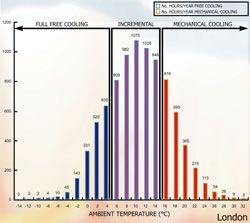
Fig 1: Free cooling potential
Free cooling utilises ambient air, when at sufficiently low temperatures, to chill one of the following:
1 The supply air to the conditioned room, by directly injecting the appropriate volume of fresh ambient air into the room, normally through the close control air conditioning unit.
2 A water/glycol mixture that is passed through an externally mounted dry air cooler to remove heat energy, the cooled fluid then being recirculated through a free cooling coil mounted within the close control air conditioning unit.
These techniques can either eliminate the need for mechanical cooling which requires one or more DX system compressors to run, or will at the very least, reduce the running time and the cooling load that would otherwise be handled entirely by mechanical cooling. The benefits of this are explained below.
Minimum mechanical cooling drastically lowers the energy consumption of the air conditioning system, reducing running costs and also minimising environmental impact. If the capital cost of such systems turns out to be higher, this additional expenditure is often recouped within a short space of time, after which the cost savings become dramatic.
Fig 1 shows the number of annual hours for London relative to ambient dry bulb temperature. The graph also shows the annual hours available for free cooling, incremental cooling and mechanical cooling, the breakdown of which is as follows:
hours/yr %
Free cooling 17011 9.4
Incremental cooling 4838 55.4
Mechanical cooling 2197 25.2
-----
8736
Full free cooling is always available at ambient temperatures of 5°C and lower to satisfy the cooling duty. It is also possible to obtain the full free cooling effect at external ambient temperatures higher than 5°C when only partial load is experienced, as is often the case during the winter months. In the full free cooling mode, the fluid circulation pump operates, circulating a cold water/glycol solution through the free cooling coil where room heat is removed and returned to the dry coolers for rejection to atmosphere. None of the compressors run in this operating mode.
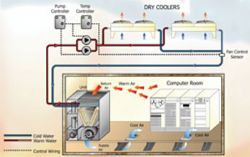
Fig 2: Full free cooling
At medium range ambient temperatures, a useful amount of partial free cooling is available. At these conditions, the pump will circulate a water/glycol solution through certain sections of the free cooling coil and then one or more mechanical cooling refrigeration circuits will provide the required additional cooling.
Fig 4 shows the detailed principle of spring/autumn operation, as generally outlined in fig 3.
If the return air temperature increases above the setpoint temperature whilst free cooling is fully operative, it is apparent that more cooling capacity is required. Under these circumstances, a proportion of the free cooling is achieved and the first stage of mechanical dx cooling is implemented. There can be a number of stages of mechanical dx cooling in a system.
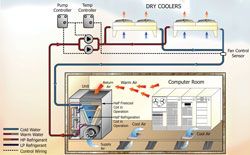
Fig 3: Incremental free cooling
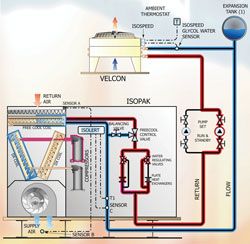
Fig 4: The detailed principle of spring/autumn operation
In Fig 4, when a stage of mechanical dx cooling is implemented, the appropriate head pressure control water regulating valve (WRV) is activated to pass a proportion of the water-glycol fluid through one of the plate heat exchangers (PHE). The function of the plate heat exchanger is to bring into heat transfer the relatively cool return water-glycol fluid coming from the free cooling coil, with the hot discharge refrigerant of the active mechanical dx cooling circuit, in order to provide condensation and sub-cooling. This results in an improved COP for the mechanical dx cooling system.
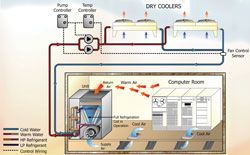
Fig 5: Direct mechanical cooling
Direct mechanical cooling
When the external ambient temperature rises to a level where free cooling is no longer possible, the system operates as a conventional glycol cooled air conditioning unit using the mechanical cooling refrigeration circuits to provide the full cooling capacity.
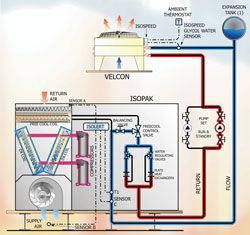
Fig 6: The system running in summer operation
Fig 6 shows the system running in summer operation. In this mode of operation the free cooling system is completely shut down, this being activated by the free cooling bypass valve (BV). The cooling load is now exclusively handled by the Mechanical DX Cooling, this being available in a number of stages, these being switched to match the instantaneous load.
The appropriate compressor head pressure control water regulating valves (WRVs) are activated to pass return water-glycol fluid through one or more of the plate heat exchangers (PHE) to effect DX condensation and sub-cooling.
Fresh air with supplementary dx cooling
This close control system approach, designed specifically for telephone exchanges and communications apparatus rooms, uses fresh air for free cooling instead of water-glycol as previously described, this being combined with mechanical DX Cooling as above
There are three modes of operation:
a) Full fresh air injection to the conditioned area via the air conditioning unit.
b) Partial free cooling via fresh air injection coupled with mixed re-circulated air.
c) Full mechanical dx cooling.
Full fresh air injection to the conditioned area via the air conditioning unit
A damper system incorporated into the air conditioning unit moves to a modulated position to allow the injection of fresh air to the conditioned area. Fresh air is the primary source of cooling with this system allowing some degree of free cooling throughout most of the year. It is essential for the fresh air to be fully filtered to a high efficiency, this being application specific, to protect the conditioned area and any equipment within.
Partial free cooling via fresh air injection coupled with room re-circulated air
A damper system incorporated into the air conditioning unit regulates the room air temperature of the conditioned area by modulating and mixing warm room return air with cooler ambient fresh air drawn in from outside.
Fresh air is the primary source of cooling with this system allowing free cooling throughout most of the year. In periods of warm weather, when the outside temperature is high the system automatically shuts off the damper and starts up the mechanical dx cooling compressors to provide all cooling via the dx coil.
Full mechanical dx cooling
In this mode, the damper is inhibited to provide full recirculation operation. Free cooling via fresh air damper is not active in this mode. A number of stages of mechanical dx cooling are used to maintain the room air temperature in accordance with the return air sensor/room mounted sensor and the controller setpoint.
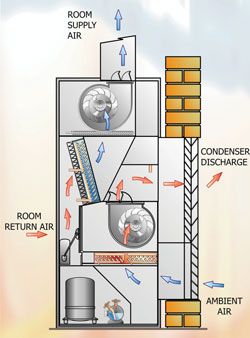
Fig 7: Full mechanical DX cooling
With thanks to Mike Creamer of Business Edge who revisits his Masterclass series of articles, updating and adding to the information which proved so useful to readers when the series was first published over ten years ago. In this reincarnation, the series will cover both air conditioning and refrigeration and serve as an on-going source of technical reference for experienced personnel as well as providing a solid educational grounding for newcomers to our industry.